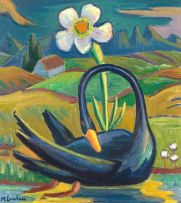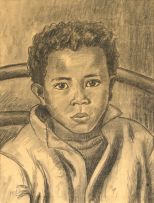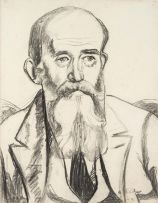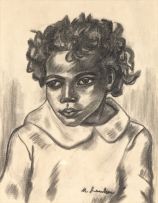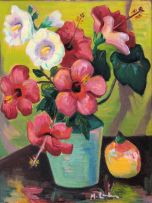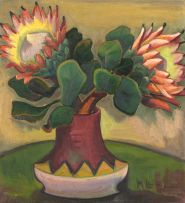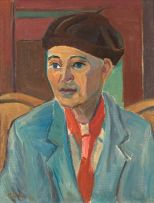Important South African & International Art, Decorative Arts & Jewellery
Live Auction, 6 March 2017
Important South African and International Art - Evening Sale
Incl. Buyer's Premium & VAT
About this Item
signed
Notes
The expressionist painter Maggie Laubser wed her radical technique to an emphatically pastoral vision. Laubser's farm upbringing near Malmesbury, and her later retreat to the farm Oortmanspoort, near Durbanville, shortly after her return from Berlin in 1924, greatly influenced her choice of subject matter. Shepherds, pickers, farm animals and flowers recur in her depictions of the Boland's agricultural landscapes. Laubser is well known having repeatedly portrayed the same limited range of subjects. Her output includes a small selection of black swans. Although executed in a figurative style, this lot offers a symbolic orchestration of subject matter that includes an oversized renosterveld daisy in the foreground and settled Boland landscape as backdrop.
In his discussion of a black swan work held in the Sanlam Art Collection, Professor Fransie Malherbe points out how natural phenomena come to appear "like apparitions from a world of fairy-tales" in Laubser's hands.1 The historian F.L. Alexander similarly speaks of her "lyrical" works as being composed of "childlike symbols".2 Early critics were flummoxed by the naïve styling of Laubser's paintings. "Time and again, Laubser found herself confronted by bewildered viewers who asked the question Why? Why cats with flowers? Why ducks with lilies?"3 Her water birds were especially seen as provocative. "It's amazing how many people develop a kind of hydrophobia from her duck paintings," wrote Johannes Meintjes, whose 1944 biography helped overhaul Laubser's reputation.4
Meintjes describes Laubser's repeated description of nature as going beyond the superficial: "It is her ambition to know every object thoroughly, so that when she reproduces a flower it is the soul of a flower being portrayed - the soul, the basic shape and characteristics of everything around her."5 In a 1956 radio interview, Laubser, then a resident in Strand, described her love of nature in almost sublime terms: "I enjoyed so much being out in the freedom and space of nature. I find it such a pity that our children of today do not know enough of nature because to be close to nature is so important for the refinement of the mind and the accentuation of the spirit."6
- FEJ Malherbe. (1959) "Maggie Laubser," in Our Art Vol. 1. Pretoria: Lantern/SABC, page 40.
- FL Alexander. (1962) Art in South Africa: Painting, Sculpture and Graphic Work since 1900. Cape Town: A.A. Balkema, page 13.
- Esmé Berman. (1993) Painting South Africa. Johannesburg: Southern Book Publishers, page 71.
- Johannes Meintjes. (1944) Maggie Laubser. Cape Town: H.A.U.M. Jacques Dusseau & Co., page 22.
- Ibid., page 14.
- E Delmont. (1989) "Maggie Laubser: Juvenilia and early South African works before 1913", in South African Journal of Cultural History, Vol.3.1, January 1989, page 60.

